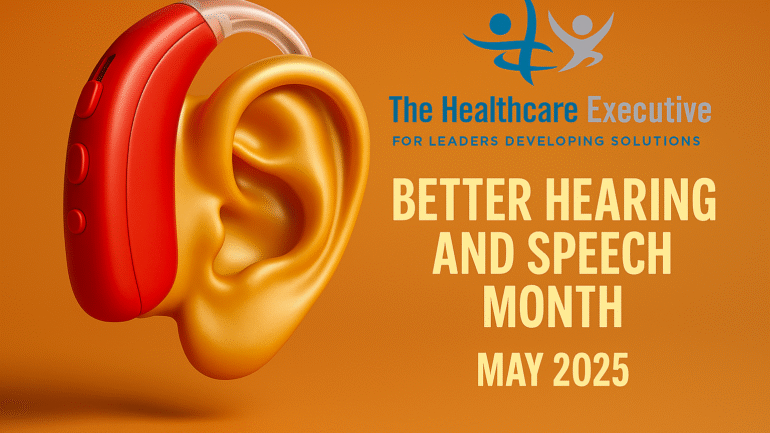Better Hearing and Speech Month – May 2025

- Posted by Greg Wahlstrom, MBA, HCM
- Posted in Health Observance Calendar
Hospital Leadership in Communication Health: Equity, Access, and Innovation
Published: May 2, 2025
May is Better Hearing and Speech Month, a national observance that calls attention to communication disorders affecting millions of Americans. These conditions range from hearing loss and speech delays to swallowing difficulties and voice disorders, impacting both children and adults across diverse communities. Yet, communication health remains chronically underfunded and poorly integrated into many health systems. Executive healthcare leaders have the opportunity—and responsibility—to change that. Organizations like Mass General Brigham are now embedding speech-language pathologists (SLPs) and audiologists directly into primary care and hospital discharge planning. The result is a more proactive, interdisciplinary approach that improves long-term outcomes and reduces readmissions. Better Hearing and Speech Month is more than an awareness campaign—it’s a leadership call to redesign how we structure, fund, and measure communication care. Health systems that lead on this front will build not just access, but trust.
Access to communication services is not equitable. Underserved and multilingual communities often face delays in evaluation and gaps in intervention. For children, this can mean missed developmental milestones. For older adults, it can lead to preventable social isolation, dementia misdiagnosis, or stroke-related complications. Hospitals must use this month to audit their audiology and SLP workflows, identify disparities, and build stronger care pipelines. At RWJBarnabas Health, executives have implemented culturally responsive care plans that embed interpreter services within SLP appointments. When hospital leaders treat language, hearing, and swallowing as core to dignity—not optional extras—they elevate the standard of care. Boards should consider communication health as part of value-based initiatives and health equity dashboards. Equity in speech-language services must be treated as an organizational quality issue, not just a referral-based specialty. The time for selective engagement is over—systemwide integration starts at the top.
Digital transformation is also changing the landscape of hearing and speech care. From remote hearing tests to AI-driven voice therapy platforms, innovation is expanding access like never before. Executives at UT Southwestern Medical Center are investing in teleaudiology hubs for rural outreach, enabling faster diagnoses and continuity of care. Virtual speech-language assessments, once rare, are now being scaled with strong clinical outcomes. However, deploying these tools effectively requires governance from the C-suite. Hospital leaders must ensure that telehealth platforms are accessible to patients with visual, hearing, or cognitive impairments. This includes training staff in universal design and trauma-informed communication techniques. Technology alone won’t solve disparities—but smart leadership can. Leaders who champion accessible digital care will also enhance patient satisfaction scores, reduce care delays, and bolster system reputation.
Leadership also involves cultivating and supporting the professionals who make this care possible. Speech-language pathologists and audiologists often face caseload overload, limited growth tracks, and isolation from broader care teams. Executives should build clear career pathways, prioritize licensure reimbursement, and include SLPs and audiologists in strategic planning discussions. Institutions like Cincinnati Children’s Hospital are leading by example with multidisciplinary teams that include communication health experts in daily rounds. Boards should also consider investing in academic partnerships and pipeline programs to train the next generation of providers—especially from historically excluded backgrounds. Workforce inclusion is not just about filling jobs—it’s about reflecting the diversity of the communities served. Elevating communication professionals is essential to workforce resilience and care quality. These are the investments that create long-term change, not short-term visibility.
Better Hearing and Speech Month 2025 is a pivotal opportunity for hospital leaders to redefine how communication care fits into health equity, patient experience, and digital modernization. From early hearing screenings in newborn units to post-stroke speech therapy in rehab centers, this work touches every department. Executive teams must develop infrastructure that moves communication disorders from specialty silos to essential services. This means reimagining EHRs, expanding insurance coverage, and amplifying the voices of those who have gone unheard—both literally and figuratively. Every patient deserves the ability to communicate with confidence, clarity, and dignity. And every health system has a role in making that happen. Leadership begins by listening—then building.
Discover More:
Explore how communication equity, workforce development, and patient experience intersect across observances like Better Hearing and Speech Month.
Internal Links
- The Healthcare Workforce Crisis: Executive Solutions That Actually Work
- World Birth Defects Day 2025: Prevention and Policy in Focus
- Rebuilding Trust in U.S. Healthcare: A Leadership Blueprint



